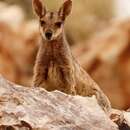en
names in breadcrumbs


The purple-necked rock-wallaby (Petrogale purpureicollis) is a species of rock-wallaby first described in 1924 by Albert Sherbourne Le Souef, then director of the Taronga Zoo in Sydney, Australia, who noted a purple colouration around the neck and cranial features that distinguish it from other rock-wallaby species.
The purple colouration was thought by some sceptical scientists to be due to the animal rubbing against a dye, but the animal does in fact secrete a purple pigment. The pigment is known to wash off in the rain and fade away after death, causing some possible confusion with other rock-wallaby species.
The species has undergone taxonomic upheaval for decades and has variously been classified as an unadorned rock-wallaby, brush-tailed rock-wallaby, and black-flanked rock-wallaby. Le Souef and others have asserted that it was a new species, and this has been affirmed by a 2001 paper in the Australian Journal of Zoology.
The purple-necked rock-wallaby (Petrogale purpureicollis) is a species of rock-wallaby first described in 1924 by Albert Sherbourne Le Souef, then director of the Taronga Zoo in Sydney, Australia, who noted a purple colouration around the neck and cranial features that distinguish it from other rock-wallaby species.
The purple colouration was thought by some sceptical scientists to be due to the animal rubbing against a dye, but the animal does in fact secrete a purple pigment. The pigment is known to wash off in the rain and fade away after death, causing some possible confusion with other rock-wallaby species.
The species has undergone taxonomic upheaval for decades and has variously been classified as an unadorned rock-wallaby, brush-tailed rock-wallaby, and black-flanked rock-wallaby. Le Souef and others have asserted that it was a new species, and this has been affirmed by a 2001 paper in the Australian Journal of Zoology.